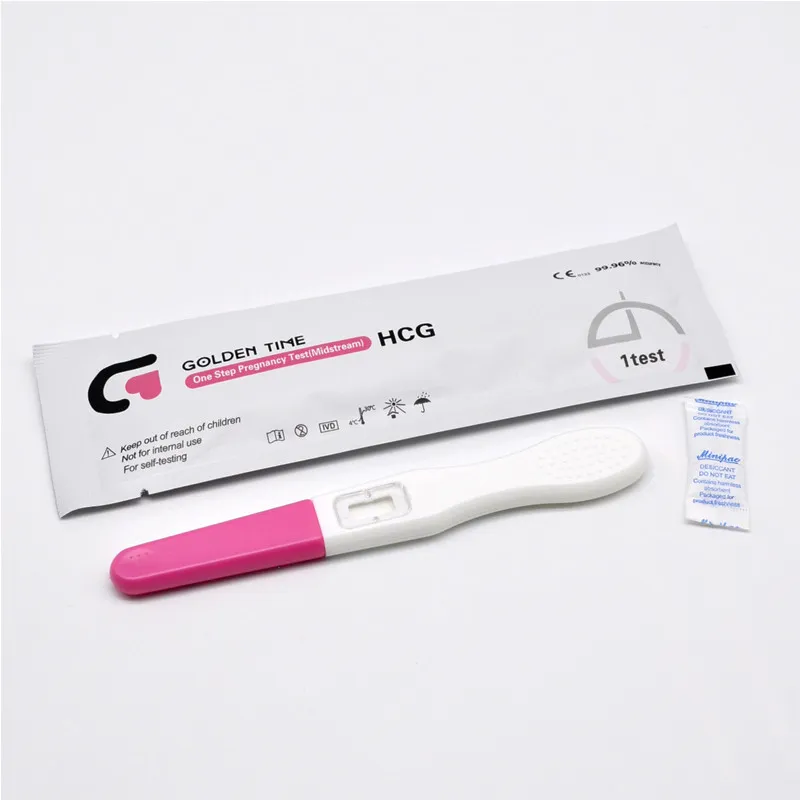jun . 26, 2025 09:57 Back to list
How Midstream Pregnancy Tests Work
The modern pregnancy midstream test has revolutionized home pregnancy detection, offering women quick and private results. These midstream pregnancy test kit devices detect human chorionic gonadotropin (hCG) in urine through innovative antibody technology. Understanding how your hcg test midstream works can help you use it more effectively and interpret results accurately. This comprehensive guide explores the science behind these tests, their evolution, and best practices for optimal results.

The Technology Behind Midstream Pregnancy Test Kit
Every pregnancy midstream test contains a sophisticated lateral flow immunoassay system. When urine enters the midstream pregnancy test kit absorbent tip, it travels through several zones containing specialized antibodies. The first zone has mobile antibodies that bind specifically to hCG molecules from the pregnancy hormone. As the urine continues flowing, these antibody-hCG complexes get captured in the test line zone of your hcg test midstream, creating the visible positive line.
The control line contains antibodies that react with the mobile antibodies regardless of hCG presence, verifying the test worked properly. High-quality pregnancy midstream test products use monoclonal antibodies that bind exclusively to the beta subunit of hCG, minimizing false positives from similar hormones. Digital midstream pregnancy test kit versions add optical sensors that interpret line intensity, removing result interpretation guesswork.
Understanding hcg test midstream Känslighet
The pregnancy midstream test detects human chorionic gonadotropin (hCG), which begins appearing in urine 7-10 days after conception. Standard midstream pregnancy test kit sensitivity ranges from 20-25 mIU/mL, while early detection hcg test midstream options can sense 10 mIU/mL. The hormone doubles every 48-72 hours in early pregnancy, explaining why tests grow darker as pregnancy progresses.
Not all pregnancy midstream test products measure hCG equally. Some budget midstream pregnancy test kit options may use polyclonal antibodies with slightly less specificity. The most accurate hcg test midstream products employ advanced antibody engineering to detect even low levels of the hormone while ignoring molecular mimics that could cause false positives. Understanding these differences helps women select tests matching their early testing needs.
Proper Usage Pregnancy Midstream Test for Accurate Results
Maximizing your pregnancy midstream test accuracy requires proper technique. First morning urine typically contains the highest hCG concentration for your midstream pregnancy test kit, though modern tests work well anytime after a 4-hour urine hold. Hold the hcg test midstream absorbent tip directly in your urine stream for 5-7 seconds, or dip for 15-20 seconds if using a collected sample.
After removing your pregnancy midstream test from urine, lay it flat while waiting the full recommended time (usually 3-5 minutes). Reading results too early or too late can lead to misinterpretation. Digital midstream pregnancy test kit models eliminate timing worries with clear "pregnant" or "not pregnant" displays. Regardless of type, never reuse an hcg test midstream as single-use construction prevents reliable repeat testing.
Evolution of Midstream Pregnancy Test Kit
The original pregnancy midstream test introduced in the 1980s represented a major improvement over test tube methods. Today's midstream pregnancy test kit options feature:
99% accuracy from conception date
Results in 1-3 minutes
Easy-grip handles
Wide absorbent tips
Splash guards
Result windows with magnification
The newest hCG test midstream innovations include:
Weeks indicator models
Bluetooth connectivity to fertility apps
Reusable digital readers
Eco-friendly materials
Earlier detection capabilities
This evolution makes modern pregnancy midstream test products more user-friendly and informative than ever before while maintaining the privacy and immediacy women value.
FAQs About Midstream Pregnancy Test Kit
How soon can a pregnancy midstream test detect pregnancy?
The most sensitive midstream pregnancy test kit options can detect hCG about 7-10 days after conception, though testing 12-14 days post-ovulation or after a missed period provides more reliable hcg test midstream results for most women.
Can medications affect my hcg test midstream results?
Fertility drugs containing hCG may cause false positives on a pregnancy midstream test. Other medications like pain relievers or antibiotics typically don't affect midstream pregnancy test kit accuracy when used as directed.
Why does my pregnancy midstream test show a faint line?
A faint line on your hcg test midstream usually indicates early pregnancy with low hCG levels. As the hormone increases, lines darken. Any line in the test zone, no matter how light, suggests pregnancy on most pregnancy midstream test products.
How accurate are dollar store midstream pregnancy test kit?
Budget midstream pregnancy test kit options often work similarly to premium tests since all FDA-cleared hcg test midstream products must meet minimum accuracy standards. However, they may lack advanced features like wide tips or easy-read displays found in higher-end pregnancy midstream test products.
Can a positive hcg test midstream result be wrong?
While rare, false positives on a pregnancy midstream test can occur from chemical pregnancies, certain medications, or test errors. A clinical blood test can confirm midstream pregnancy test kit results if any doubt exists.
Today's pregnancy midstream test options combine cutting-edge science with user-friendly design to deliver accurate, early results in the privacy of your home. Whether you choose a basic midstream pregnancy test kit or advanced hcg test midstream with digital features, understanding how these tests work empowers you to use them effectively during this important life moment.
For women seeking reliable, stress-free pregnancy detection, investing in quality pregnancy midstream test products makes all the difference. Explore our selection of clinically validated midstream pregnancy test kit options today—because when it comes to life-changing results, you deserve the best technology available in an hcg test midstream. Your journey to certainty starts here.

